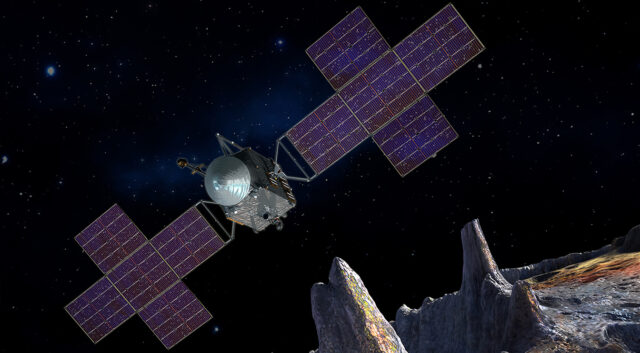This site may earn affiliate commissions from the links on this page. Terms of use.
We’ll have to wait a little longer to find out what’s up with one of the most interesting asteroids in the solar system. NASA has confirmed that a minor software glitch will cause a delay for its upcoming Psyche mission, which was set to launch in September 2022. The motion of the planets is working against NASA here, so even a small delay means Psyche won’t be able to launch in 2022 at all, and that puts the science phase of the mission toward the end of the decade.
Psyche (the spacecraft) is named after the asteroid it will eventually visit. 16 Psyche (the asteroid) sits in the great asteroid belt along with uncountable other space rocks, but this one is special enough that NASA wants to get a closer look. It’s the largest known M-type asteroid, meaning it’s rich in metals. Scientists have speculated that Psyche is the exposed core of a planet that was smashed to pieces by impacts early in its formation.
Naturally, getting a closer look at a planetary core is an alluring possibility. Researchers at MIT released the best map of Psyche’s surface yet, which could help NASA plan its observational campaign, and now the team will have more time to go over it.
NASA says that it found a small issue with the flight software, which caused the initial delay from August to September. However, testing and validation of the fix won’t be done in time. The software in question manages the probe’s orientation and trajectory, and that system needs to work perfectly to ensure it can point its antennas at Earth. No communication, no mission.

Even with the powerful Falcon Heavy launch vehicle, NASA is at the mercy of physics here. The launch window closes on October 11 — after that, Earth will be moving away from Psyche, and NASA won’t have time to complete testing before the window closes. The only choice is to wait for Earth to make an orbit and launch Psyche in 2023.
Before the delay, NASA expected Psyche to reach its target by 2026. If the 2023 launch goes ahead, the probe should reach the asteroid in 2029. There’s also a 2024 window that is not entirely out of the question, which would deliver the spacecraft by 2030. NASA was also hoping to use the Falcon Heavy’s massive payload capacity to send two “ride-along” missions with Psyche. The Janus mission was set to study binary asteroids, and the Deep Space Optical Communications technology demonstration is intended to test hi-speed laser communications with Psyche. NASA is evaluating both missions to see if they will go ahead as planned.
Now Read:
Source by www.extremetech.com





























